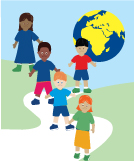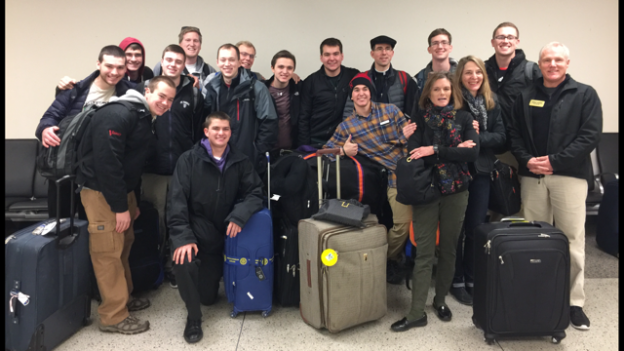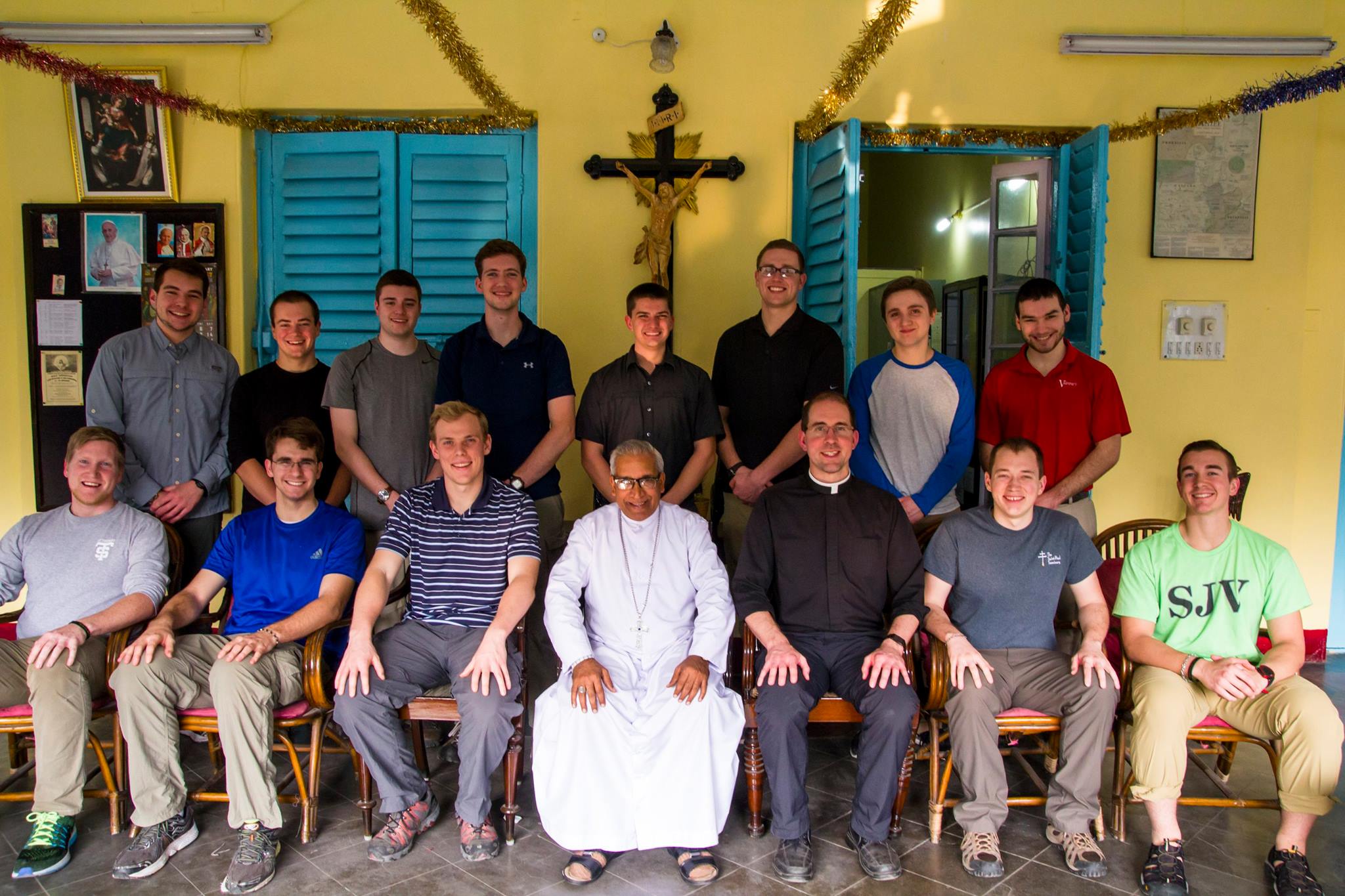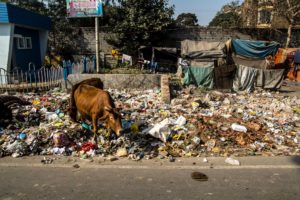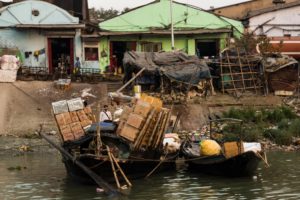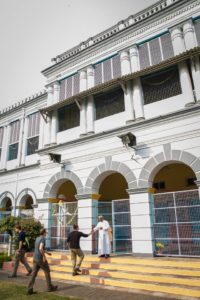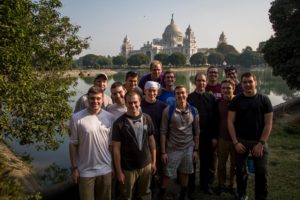December 31st – St. John Vianney seminarians, Father Borello and traveling companions at Twin Cities airport preparing to leave to Kolkata to work with Mother Teresa’s Sisters and to work in Pathways Jan Seva School and Clinics & picture of them in Kolkata. Below are some of the blogs written by the seminarians during their trip in Kolkata.
Friday, January 11, 2017
Our visit to the Leper Colony
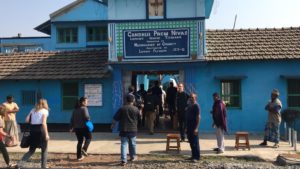
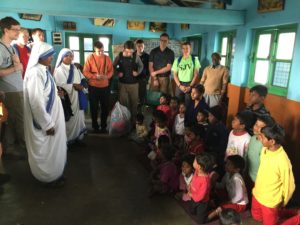
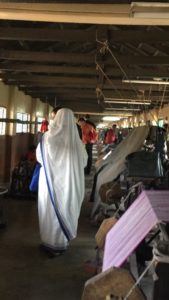
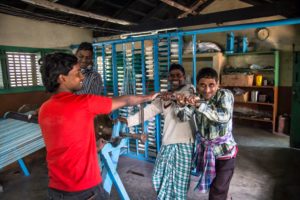
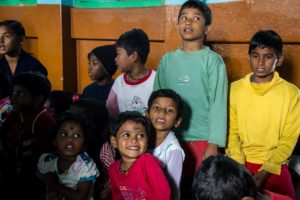
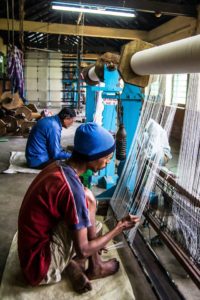
Safely across, we entered through a gateway into the center of a sprawling complex. It was three football fields longs both to the left and to the right, with one field for its depth. Pat filled us in to some of the particulars of the colony. Promising to tell us more, he later guided us into the school. The 20 children welcomed us in with singing voices. My heart was moved by their smiles and beautiful voices. My brothers broke out their instruments and we started to sing for the kids. When we finished our tunes we handed them the gifts from America. Then to our surprise they had a song and dance for us before we left.
Pat then guided us on to the loom shop. The loom room was a building 20 feet wide that stretched beyond sight. we entered the first room containing a few people spinning thread on bobbins and two people running looms. We greeted each person as we passed single fill between the spinners on our left and the weavers on our right. Passing through a door this first room opened up into the long room, and we gasped as we began to understand the vast scale of this operation. In this room was filled with the constant clack, clack, clack of the shuttle weaving its thread to make the cloths. As we passed through the building we saw the many clothes and fabrics that we used in our work sites being made. We saw the creation of bed sheet, bandages, and the sisters sarees. The speed and coordination of the workers impressed me greatly, as I stopped and marveled at how the looms wove the threads in fabric. At the end of the building we saw men preparing the looms, and the bobbins being spun onto the drums.
We left walking the length of the building again outside, as we headed for the room of the leper patients. The men were in several rooms with beds against the walls and an aisle down the middle. I looked each person in the eyes and greeted them with a smile. Some smiled backed and greeted me in return with a namaste. The women building was bigger with beds along the walls and a row of beds down the middle. It was harder for me to greet the women, because it had sunk in that there was nothing that I could do for these people with Hansen’s disease. After the last building we quietly walked back to the room across the tracks where we started. Pat then told us more about the practical facts of Hansen’s disease, and his words sunk in after seeing the patients. Pat then took the time to field our many questions. We left a little more serious, with a lot to think about on our two hour bus ride back into the heart of the city.
Nathan Hansen-Diocese of New Ulm
Learning New Languages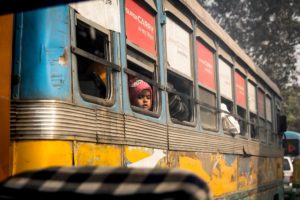
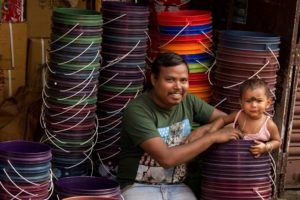
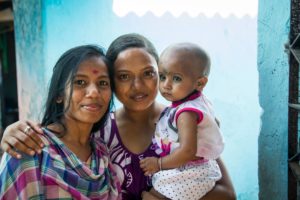
Two days ago I had the privilege of visiting Nirmal Hriday, the Missionaries of Charity home for the dying in Kolkata. I had previously served for three mornings at the home, and had gotten to know several of the residents. So, I was looking forward to visiting. On arriving, I greeted one of the men who knows English well. In the meantime, a few of my brother seminarians broke out instruments and began singing. After a short conversation with the man who knows English, I moved over to one of the other residents I know. This man is sunken with starvation. He is so malnourished that he cannot walk, he can barely move his arms, and one of his hands is completely crippled. The first day I spent at the home, I massaged the man for almost an hour, working his arms and hands in an attempt to restore their motion. Since he speaks no English, I spent that entire time with him simply trying to interpret his head nods and eye movements. While he could not communicate what he wanted, I picked up on something much deeper that I have yet to fully understand—suffering. This man, left for dead on the streets of Kolkata, was suffering immensely. At first, I was frustrated, because I could not understand his suffering. I took my frustration to prayer, but my understanding would only come slowly. As I worked with this man over the next few days, I gradually came to communicate with him a little through eye contact and head nods. But, more importantly, I began to love this suffering man. If I have learned one thing from the Missionaries of Charity, I have learned that they love people as they are—broken, suffering, with all the strings attached. Their mission is to fulfill the deepest thirst of all—the thirst for love. Without even realizing how, I began to see this man as my brother. As I came to see him this way, I desired to alleviate his thirst for love. Every time I served this man, I tried to convey the Father’s love for him. Now, while just stopping in for a visit, I had the chance to sit by him and listen to the music.
While I was sitting there, the man asked me for some things, which I actually understood and did for him. But then, he did something I had not seen him do yet—he smiled at me. At long last, this man knew that I loved him, received this love, and returned it with a smile. This simple gesture meant the world to me as I just looked into his eyes with love and gratitude. That moment will never leave me. The look of gratitude on that man’s face for the meager service and love I gave him could have warmed the coldest heart.
Tomorrow, I go back to the home for the dying. I hope to see him there, in his usual place. I just learned the Bengali phrase for “I love you.” What better words to leave with a dying man.
Peter Ludwig- Diocese of Lansing Michigan
Making new friends
After a boat ride on the boarder of Bangladesh and running through the rice paddy of rural India, the brothers and I boarded the bus to Morning Star Seminary. We arrived at 8pm, amid the darkness of night and weariness of the journey to the sounds of native drums and singing. The welcome by the 205 seminarians was beautiful and unexpected the dawned us with leis of flowers around our neck as a sign of their gratitude for our being their – the foreigners to visit this house of formation. Dinner was fantastic and then it was off bed – sweet sweet bed – in order to get a full nights rest before we joined the seminarians in the their daily routine of 6am Morning Prayer followed by Holy Mass. In praying the prayer of the Church with our brothers on the other end of the world, we had a concrete and beautiful experience of the Catholic – which means universal – Church.
The brothers at Morning Star continued the remarkable Indian hospitality we have all experience through this voyage with breakfast and what I will call a “program of gratitude.” This “Program of gratitude” included welcoming us again, teaching us about their Seminary and Country. The dances and way the brothers welcomed us into their community allowed me to see again some of the beautiful qualities of the Church in India – gratitude and a spirit of community. In the USA we have so much and it is easy for me to become accustomed to all that we have, but the brothers give thanks to God for all the good in their lives because the see the immediate world around them and understand that the could have things worse. The appreciation for our visit, had less to do with us, and more to do with the thankful disposition of the seminarians – such a disposition lends them to say things like “a visit from someone is like a visit from God Himself.”
After this program, we had some time to meet in small groups with the seminarians studying philosophy. I was in a group with Micheal and David S., We shared our vocation story’s ane the struggles and joys that come with the life of a seminarian. The brothers from Kolkata shared their struggles and joys that come with living a radically Christian life, one brother shared a story from when he was fourteen, His teacher was killed by a radical Hindu group. This attack was a response to their leader being killed, the Hindus thought that the Christians had killed the leader, but the killers were in fact non-Christian terrorists. The attack left him to literally run for his life into a thick wooded area, He walked for many kilometers from village to village to see where he could find some food. He and the other children his was with witnessed many villages with the churches burned, no food to be found, and priests and religious killed. The experience laid out before me made me keenly aware of the blessings that we have in the USA. We are certainly not with out problems but this story and this trip have made me grateful for that Country and my Faith.
Small groups concluded with lunch. After Lunch we had some time to rest and pray, and 3pm initiated an international game of Basketball. It was a hard fought game, a close game, an injury-free game, and we came out on top USA 39- India 37, we could not have asked for a better game.
I was taken aback by the simplicity of the brothers, the unity of all of them despite cultural differences, and their singleness of purpose. As a result of visiting the brothers, I desire to remain in the presence of our Lord.Joe Domina-Diocese of Lafayette in Indiana
A Day at Pathways Jan Seva School
A blog below from the seminarians who visited Pathways Jan Seva School in Kolkata. A must read!
Friday, January 6, 2017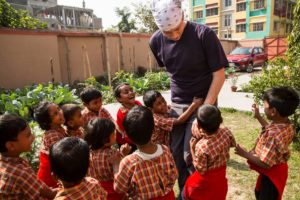
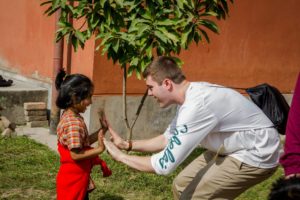

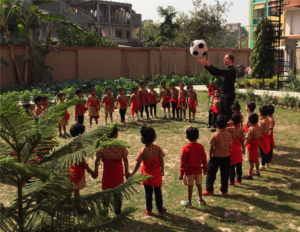
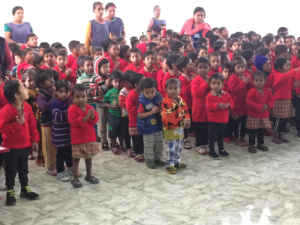
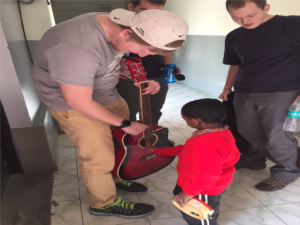
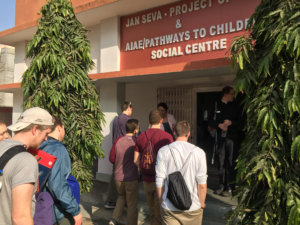
Today we had the opportunity to visit the Pathways Jan Seva that is located here in Kolkata. This school was started to help young mothers who cannot afford proper education for their children a chance for their children to receive a well-rounded education with free tuition. The school has over 200 students ranging between 2 and 6 years old. We were given the opportunity to see the daily school and classroom activities of the children, while also getting to interact with them. Some of us were able to go around to different classrooms, doing things such as playing guitar and drums for the children, while the rest of us were able to play with all of them outside.
After two days of working with the Missionaries of Charity that were rewarding and tiring, this day was a welcomed break for all of us. Working in homes for the sick and the dying requires a volunteer to give every ounce of their being in order to bring joy to those who are suffering and in so much pain. While there is joy present in all people, even those who suffer the most, it can be very difficult to witness the great pain and depravity; it can even boarder onto feelings of hopelessness and despair. However, today at Pathways, we were able to receive joy in its most pure form. At Pathways, it is hard not to constantly smile, to constantly be filled with joy, seeing these children, the opportunity they are being given, and the carefree attitude and happiness they exude, even amidst some of the most depressing sights.
In our short time at Pathways, we were able to see just how much the organization does for these children. Pathways is able to take children from some of the poorest families, put them in an environment of stability, education, and love, and prepare them for, hopefully, a better life. Pathways, however, does not stop with helping just the child. The organization goes out of its way to look after mothers of children, some of whom have been abandoned by their husbands and left to fend for themselves and their children. Pathways seeks to give a better life for the whole family, educating mothers in order to better care for and support their children. Ultimately, it was amazing to see how Pathways is able to change the lives of these individuals, children and adults, in this section of Kolkata. Sometimes, the only way to change a situation or environment is through individuals and through relationships. This is what Pathways is doing in looking after the whole family, instilling love and a value for education, in order to slowly change the city.
The great care that Pathways has for the families can be reciprocated and seen the other way, with families being so grateful for all Pathways has done for them. Three of us had the opportunity to walk the streets of Kolkata to two small homes to visit two alumni of the school. Even after being exposed to this city for three days already, it was still shocking to see these houses. The size of these houses is comparable to a small walk-in closet and families with up to five or six children all lived there together. It was most certainly the poorest living conditions I have seen. However, even with all of these facts, it was amazing to see how generous and grateful all of the families were. We had the opportunity to visit two houses, and in both instances, the mothers were very hospitable, offering tea and a place to sit. They completely gave of themselves, even when they had barely anything to give. It brought so much joy to each of us to see the love and hospitality the mothers had for us after having just met us.
These mothers’ love for Pathways was just as visible. The children we visited who were alumni of the school remembered many things they learned from Pathways and were so excited to see former members of the school. One girl even went so far as to call the founder of the school a “second mom” to her.
All of these experiences opened my mind even more to the culture of extreme poverty we have been surrounded by for many days. Having these experiences with the children and with the families of the children allowed my brother seminarians and myself to recharge, to encounter the love of the Lord in the simple smile of a child, and to see that generosity and hospitality are not dependent on wealth or financial security, but simply on gratitude and love.
Day One of the Saint John Vianney Mission Trip…Complete. So far, no debilitating illnesses or injuries, which is always a plus. Today was our first full day on site working with the Missionaries of Charity. The night before was the first time in 40+ hours that we laid horizontal in a comfortable spot that wasn’t an airport bench. So, needless to say…we slept like rocks our first night–despite the perpetual car horns and barking of dogs. Morning came very early as we jumped right into things, waking up at 4:50am for a light breakfast provided by our hosts at the Fairlawn. A few swigs of “chai” (tea) and it was off to the Missionaries’ for 6:00am Mass. It wasn’t our first time at the Motherhouse though, as we made a short visit on Monday (the day we arrived in Kolkata) to pray at the tomb and have Mass literally beside the tomb of Saint Mother Teresa.
After Mass, we gathered in a community room to meet other volunteers and to have a quick banana with a slice of bread and chai. Some of the other volunteers came all the way from Chile, the Philippines, France, and the U.S. It wasn’t long before we split up into our groups that we would be serving with for the duration of our visit. Each of us were assigned two locations– one to visit in the morning from 7:30-11:45am, the other in the afternoon from 3:00-5:15pm. Our means of transportation are two 17-passenger buses. Once we arrived at our volunteer sites, the Sisters had us busy with much good work. The names of some of the sites include Prem Dan (mentally handicapped/sick), Nirmal Hrady or Kali Dad (dying/destitute), and Daya Dan (children in need). At lunch time, we were picked up and brought back to our accommodations to eat before resting for awhile. One group had to walk back since they were taking extra time to assist at the volunteer site. Around 3:00pm, the buses delivered us to different locations where we helped serve dinner and prepare the sleeping quarters for the night. By 5:15, the day of volunteering was over. Most of us spent our mornings helping with laundry (either scrubbing or repeatedly rinsing soiled linens and clothes) while the afternoons allowed for more personal interaction.
For dinner, our group was able to venture out on the town to a restaurant serving yummy local fare, complete with its own soap-tasting, green popsicle for dessert. The food was delicious and did well to introduce us to all kinds of native cuisine, especially with all the different spices (cumin, cardamon, coriander, curry, masala, chile, etc.)
One prominent grace form the day was being able to live out the joy that the Missionaries of Charity always carry with them to the Poor. For instance, before we set out from the Motherhouse in the morning, everyone sings a song. The song, which repeats “…We find our hope in Jesus, … Jesus is our joy” is one that you actually want to have stuck in your head. This little “hymn to Joy” along with reception of Our Eucharistic Lord animates the entire rest of the day. That is the perfect meditation for serving Christ in His Poor. One of us met an 85-year-old man named “Arun” who reminded us of our 91-year-old grandfather. Moments like this of genuine conversation with someone who speaks just enough English is a special occasion to live out the Joy of Christ. But what we have found for certain from our experience so far is that everyone speaks a common language that surpasses all others. Love.
Kyle Loecker-Archdiocese of Omaha
Seminarians at first Mass at Mother Teresa’s.
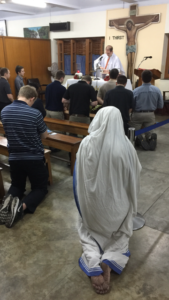
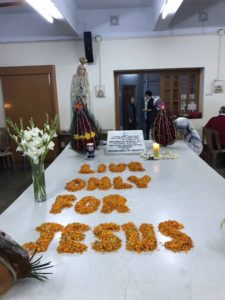
Clink the link to download all the blogs written during the trip Seminarian Blogs




